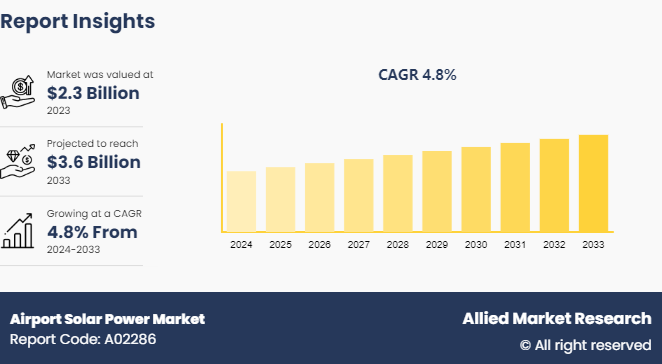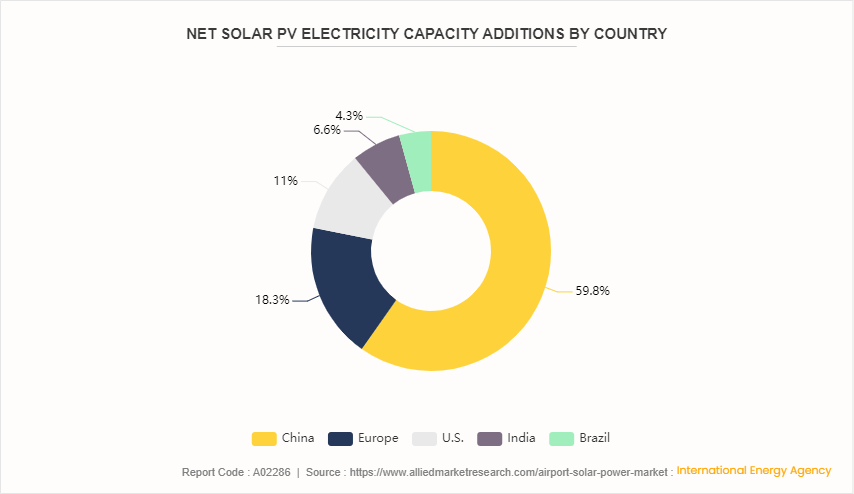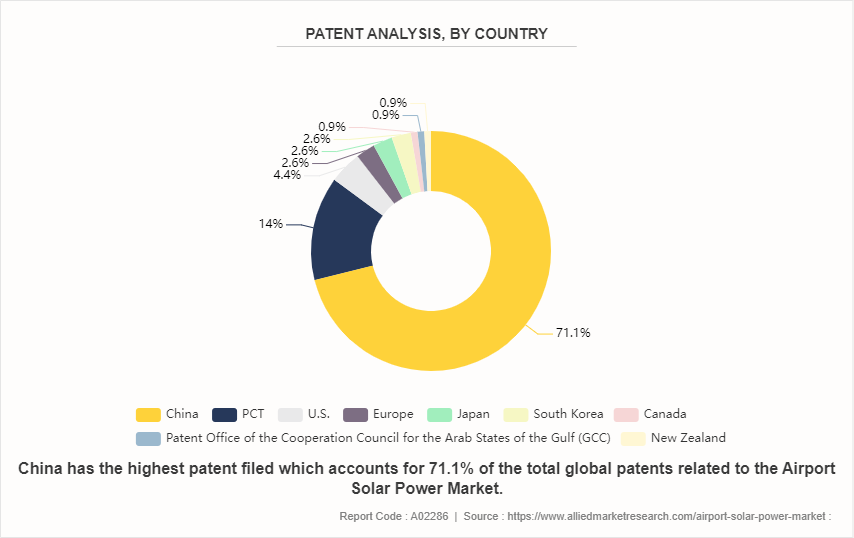Airport Solar Power Market Research, 2033
The global airport solar power market was valued at $2.3 billion in 2023, and is projected to reach $3.6 billion by 2033, growing at a CAGR of 4.8% from 2024 to 2033.

Market Introduction and Definition
Airport solar power refers to the use of solar energy systems installed at airports to generate electricity. This sustainable energy solution leverages photovoltaic (PV) panels to convert sunlight into usable electrical power. Airports are increasingly adopting solar power due to its environmental benefits and potential cost savings.
Solar power systems at airports typically include large arrays of PV panels installed on rooftops, parking areas, or dedicated solar farms. These installations help reduce reliance on fossil fuels, decrease greenhouse gas emissions, and lower electricity costs. Solar power systems are designed to withstand harsh weather conditions, including high winds and intense sunlight, which are common in airport environments. They are also equipped with energy storage solutions, such as batteries, to ensure a reliable power supply even when sunlight is not available. In addition, integrating solar power at airports can enhance the facility's energy resilience, contributing to more stable operations and reducing the risk of power outages. Overall, airport solar power represents a forward-looking approach to energy management, aligning with global sustainability goals and supporting the efficient functioning of modern aviation infrastructure.
Key Takeaways
- The Airport solar power market report study covers 20 countries. The research includes a segment analysis of each country in terms of value ($Billion) for the projected period 2024-2033.
- More than 1, 700 product literatures, industry releases, annual reports, and other such documents of major Airport solar power industry participants along with authentic industry journals, trade associations' releases, and government websites have been reviewed for generating high-value industry insights.
- The study integrated high-quality data, professional opinions and analysis, and critical independent perspectives. The research approach is intended to provide a balanced view of global markets and to assist stakeholders in making educated decisions to achieve their most ambitious growth objectives.
Key Market Dynamics
The increased focus on sustainability is set to drive significant growth in the airport solar power market size. Airports worldwide are adopting solar power to reduce their carbon footprint and enhance energy efficiency. Solar installations provide a renewable energy source, lower operational costs, and align with global environmental goals. With stringent regulations and rising fuel costs, solar power becomes an attractive option for airports aiming to achieve net-zero emissions. The integration of solar panels into airport infrastructure, such as rooftops and parking areas, maximizes space utilization while generating substantial energy. Additionally, government incentives and investments in green technologies further support the expansion of solar power at airports. This shift towards sustainable practices not only helps in meeting regulatory requirements but also enhances the airport's public image and operational resilience. As a result, the airport solar power market is poised for robust growth, driven by environmental concerns and the financial benefits of renewable energy adoption.
The airport solar power market growth is expected to be hampered by the high initial investment required for installation and infrastructure. Setting up solar power systems at airports involves substantial capital expenditure for purchasing solar panels, inverters, batteries, and other necessary equipment. Additionally, integrating these systems into existing airport infrastructure requires significant modifications and upgrades, further escalating costs. The financial burden is particularly challenging for smaller airports with limited budgets, which may find it difficult to justify the high upfront costs despite the long-term benefits of solar energy. Moreover, securing funding and navigating through complex regulatory approvals can delay project implementation, affecting market momentum. While larger airports and government-backed projects might have the resources to invest in solar power, the high initial costs remain a significant barrier for widespread adoption across the industry, slowing down the overall market growth for airport solar power.
Technological innovations in energy storage are set to drive significant growth in the airport solar power market shares. Advanced energy storage systems, such as high-capacity lithium-ion batteries and flow batteries, enhance the efficiency and reliability of solar power by ensuring a consistent energy supply even during low sunlight conditions. These innovations enable airports to harness solar energy more effectively, reducing reliance on traditional power sources and lowering operational costs. Additionally, the integration of smart grid technologies allows for better energy management and distribution, optimizing power usage across airport facilities. As airports increasingly adopt renewable energy solutions to meet sustainability goals, the enhanced capabilities of modern energy storage systems will provide a robust infrastructure to support large-scale solar power installations. This not only aligns with global environmental targets but also presents lucrative opportunities for market players to develop and implement cutting-edge energy solutions, propelling the airport solar power market forecasts towards substantial growth.
The Expansion of Net Solar PV Electricity Capacity is a Major Factor Propelling the Growth of the Airport Solar Power Market.
Increasing net solar PV electricity capacity is significantly driving the growth of the airport solar power market. Airports, with their expansive roof spaces and available land, are increasingly adopting solar PV systems to harness renewable energy and reduce operational costs. As solar technology becomes more efficient and cost-effective, airports are investing in large-scale solar installations to meet sustainability goals and lower energy bills. This trend is further supported by regulatory incentives and the growing emphasis on green infrastructure, leading to a surge in airport solar power projects and contributing to the overall expansion of the market.

Patent Analysis of the Global Airport Solar Power Market
In the airport solar power market, patent filings are predominantly concentrated in China, which holds a substantial 71.1% share, indicating its leading role in innovation and development in this sector. The Patent Cooperation Treaty (PCT) filings account for 14%, reflecting significant international interest and collaborative efforts. The U.S. holds a 4.4% share, showcasing its ongoing advancements in airport solar technology. Europe, Japan, and South Korea each contribute 2.6%, while Canada, the GCC, and New Zealand each have a modest 0.9%. This distribution highlights China’s dominance and the global interest in advancing airport solar power solutions.

Market Segmentation
The airport solar power market is segmented into components, application, and region. Based on component, the market is classified into solar panels, inverters, batteries, mounting systems and others. By application, the market is divided into terminal buildings, runways and taxiways, parking areas, cargo areas and others. Region-wise the market is analyzed across North America, Europe, Asia-Pacific, and LAMEA.
Competitive Landscape
The major players operating in the airport solar power market include First Solar Inc., Canadian Solar Inc., SunPower Corporation, Tata Power Solar Systems Ltd., Jinko Solar Co., Ltd., Trina Solar Limited, Enel Green Power S.p.A., Schneider Electric S.E., Siemens AG, ABB Ltd.
Regional Market Outlook
Asia-Pacific is experiencing robust economic growth. The airport solar power market overview in the Asia-Pacific region is experiencing significant growth, driven by increasing investments in renewable energy and sustainability initiatives. Countries like China, India, and Australia are leading the adoption, with several airports installing solar power systems to reduce carbon footprints and operational costs. The market is supported by government policies, subsidies, and a growing focus on green airport infrastructure. Key players are partnering with airports to develop large-scale solar projects, contributing to energy self-sufficiency and environmental goals. The Asia-Pacific market is poised for continued expansion as more airports integrate solar power into their energy strategies.
- The Asia-Pacific region currently leads in airport construction projects, including runways and terminals, with over 220 projects underway. Additionally, the region has more than 110 greenfield projects in the planning stage, the highest globally. China and India are the primary drivers of this growth in airport investments.
- According to IATA, China plans to construct 216 new airports by 2035, while the Indian government aims to develop 100 additional airports by 2024. This presents a significant opportunity for airport information system integrators, as the adoption of smart airport concepts is expected to increase the demand for advanced airport information systems during the forecast period.
- In July 2022, India's flagship airline, Air India, selected the Amadeus Altea Passenger Service System Suite (PSS) as part of its revitalization efforts, encompassing revenue management, revenue accounting, retailing & merchandising, and website management.
- Therefore, Asia-Pacific is projected to emerge as a dominant force in the Airport solar power market throughout the forecast period.
Industry Trends:
- The airport solar power market is experiencing significant growth, driven by increasing environmental regulations, rising energy costs, and the need for sustainable infrastructure. Airports globally are turning to solar power to enhance their energy efficiency and reduce carbon footprints. A notable trend is the integration of large-scale solar installations on airport rooftops, parking lots, and adjacent lands. For instance, Los Angeles International Airport (LAX) has implemented a major solar power initiative with a 10-megawatt solar array installed on the rooftops of its parking structures, significantly reducing its reliance on conventional energy sources.
- Another trend is the adoption of innovative solar technologies, such as photovoltaic (PV) panels embedded in pavements and runways. This technology is being explored for its potential to generate power without occupying additional land.
- Singapore's Changi Airport is a leading example, having launched a project to integrate solar panels with its existing infrastructure, including its terminals and cargo buildings. This approach helps harness solar energy and maximizes the use of available space.
- The move towards hybrid solar systems is also gaining traction, combining solar energy with energy storage solutions to ensure a consistent power supply. The Sydney Airport in Australia is investing in battery storage systems to store excess solar energy generated during the day for use during peak hours or at night.
- In addition, airports are focusing on smart grid integration, which allows for better management and distribution of solar power within the airport's energy network. This trend is exemplified by the airport's implementation of energy management systems to optimize solar power usage and improve overall operational efficiency.
Key Sources Referred
- Ericsson Mobility Report
- IEA
- IATA
- Our World in Data
- The Ministry of Power
- The National Institution for Transforming India (NITI Aayog)
- Airports Authority of India (AAI)
- The Ministry of Civil Aviation
Key Benefits For Stakeholders
- This report provides a quantitative analysis of the market segments, current trends, estimations, and dynamics of the airport solar power market analysis from 2024 to 2033 to identify the prevailing airport solar power market opportunities.
- The market research is offered along with information related to key drivers, restraints, and opportunities.
- Porter's five forces analysis highlights the potency of buyers and suppliers to enable stakeholders make profit-oriented business decisions and strengthen their supplier-buyer network.
- In-depth analysis of the airport solar power market segmentation assists to determine the prevailing market opportunities.
- Major countries in each region are mapped according to their revenue contribution to the global market.
- Market player positioning facilitates benchmarking and provides a clear understanding of the present position of the market players.
- The report includes the analysis of the regional as well as global airport solar power market trends, key players, market segments, application areas, and market growth strategies.
Airport Solar Power Market Report Highlights
| Aspects | Details |
| Market Size By 2033 | USD 3.6 Billion |
| Growth Rate | CAGR of 4.8% |
| Forecast period | 2024 - 2033 |
| Report Pages | 280 |
| By Component |
|
| By Application |
|
| By Region |
|
| Key Market Players | Siemens AG, Schneider Electric S.E., ABB Ltd., Enel Green Power S.p.A., SunPower Corporation, Trina Solar Limited, First Solar, Inc., Canadian solar Inc., Tata Power Solar Systems Ltd., Jinko Solar Co., Ltd. |
| Other Key Market Players | LDK Solar, Borrego Solar System, Brightsource Energy |
The airport solar power market was valued at $2.3 billion in 2023 and is estimated to reach $3.6 billion by 2033, exhibiting a CAGR of 4.8% from 2024 to 2033.
Government incentives and subsidies is the upcoming trend of Airport Solar Power Market in the globe.
First Solar Inc., Canadian Solar Inc., SunPower Corporation, Tata Power Solar Systems Ltd., Jinko Solar Co., Ltd., Trina Solar Limited, Enel Green Power S.p.A., Schneider Electric S.E., Siemens AG, ABB Ltd. are the top companies to hold the market share in Airport Solar Power.
Terminal buildings is the leading application of Airport Solar Power Market.
Asia-Pacific is the largest regional market for Airport Solar Power.
Loading Table Of Content...


